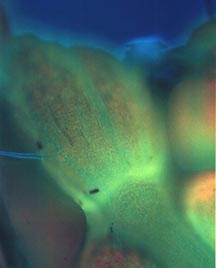Natasha S Myers: Difference between revisions
| Line 17: | Line 17: | ||
*“Molecular Embodiments and the Body-work of Modeling in Protein Crystallography” is forthcoming in the journal ''Social Studies of Science''. | *“Molecular Embodiments and the Body-work of Modeling in Protein Crystallography” is forthcoming in the journal ''Social Studies of Science''. | ||
*"Animating Mechanism: Animation, Affect, and Intra-animacy Among Protein Modelers" is forthcoming in a special issue on Feminist Technoscience in the journal "Science Studies" | |||
*"Performing the Protein Fold: The Pedagogical Lives of Molecular Models" is forthcoming in ''The Inner History of Devices'', edited by Sherry Turkle. | *"Performing the Protein Fold: The Pedagogical Lives of Molecular Models" is forthcoming in ''The Inner History of Devices'', edited by Sherry Turkle. | ||
== Awards == | |||
Nicholas Mullins Award, Society for Social Studies of Science. The Mullins Award is a prize awarded to one graduate student each year for outsanding scholarship in science and technology studies. | |||
MIT Siegel Prize, Honorable Mention. The Siegel Prize is awarded to an MIT student for best essay on science, technology and society. | |||
== Current CV == | == Current CV == | ||
Revision as of 14:15, 8 November 2006
Natasha Myers
SSHRC Doctoral Candidate
Program in History, Anthropology, and Science, Technology, and Society
Massachusetts Institute of Technology
nmyers@mit.edu
Web Site: web.mit.edu/nmyers/www
Areas of Interest
- structural biology // biological engineering // molecular machines // anthropology and history of science // modeling, imaging and simulation // pedagogy // embodiment // tacit knowledge // gesture and affect // performance of scientific knowledge // ...
Description of Research
- Natasha’s dissertation research explores the lively visual cultures of twenty-first-century structural biology and biological engineering, with a focus on pedagogy and training in the arts of molecular visualization. This ethnography examines the making of a new generation of life scientists and the formation of professional identities around novel three- and four-dimensional imaging, modeling and simulation techniques that can render living bodies visible at the molecular scale. As visualization practices change, she is observing the emergence of new modes of embodiment and biological imaginations, tracking how they propagate in pedagogical and professional contexts, including classrooms, teaching laboratories, research labs, and conferences. She examines how proteins are figured and continually reconfigured as simultaneously machinic and lively, looking at how the mechanisms of ‘molecular machines’ are conceptualized and performed through gestures and affects that scientists use to flesh-out, animate and relay their embodied knowledge of molecular forms and movements.
Publications
- “Molecular Embodiments and the Body-work of Modeling in Protein Crystallography” is forthcoming in the journal Social Studies of Science.
- "Animating Mechanism: Animation, Affect, and Intra-animacy Among Protein Modelers" is forthcoming in a special issue on Feminist Technoscience in the journal "Science Studies"
- "Performing the Protein Fold: The Pedagogical Lives of Molecular Models" is forthcoming in The Inner History of Devices, edited by Sherry Turkle.
Awards
Nicholas Mullins Award, Society for Social Studies of Science. The Mullins Award is a prize awarded to one graduate student each year for outsanding scholarship in science and technology studies.
MIT Siegel Prize, Honorable Mention. The Siegel Prize is awarded to an MIT student for best essay on science, technology and society.
Current CV
Click here for pdf of current CV
Bodies in Time: Dance, Plants and Biological Visualization ...
Genetically modified Arabidopsis thaliana flower bud expressing green fluorescent protein, visualized under ultraviolet light.
Micrograph by Natasha Myers
For more on my dance and imaging projects see http://web.mit.edu/nmyers/www
